Winter pleasures don’t get much simpler than a steaming pot of Irish stew: cheap, easy and gloriously warming, they’re the culinary equivalent of a big woolly scarf. Yet, with so many much-loved traditional dishes, the recipe itself is a bubbling cauldron of controversy: hardline purists maintain that it should contain nothing but meat, onions, potatoes and water, while others proffer treasured family recipes thickened with pearl barley, or sweetened with root vegetables.
Sadly, I can’t remember my Dublin-born grandma ever making such a thing (possibly because my mum is the only Irish citizen ever to scorn the spud), so I can’t offer my own version. On the bright side, this leaves me the freedom to be slightly more objective about what works and what doesn’t. Having said that, on the downside, I’ll probably have to go into hiding. Here goes …
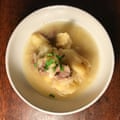
The meat
Though you’ll find many recipes online calling for beef, especially by American writers (lamb being so puzzling unpopular in the US that, as recently as 2011, more than half the population had never even tasted the stuff), Irish stew is made with sheep meat. On that point, even I won’t budge. Strictly speaking, it ought to be mutton or even kid goat, because, as historian Regina Sexton points out in The Oxford Companion to Food, in days gone by, “the economic importance of sheep lay in their wool and milk produce, and thus ensured that only old or economically non-viable animals ended up in the cooking pot”.
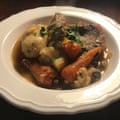
But few modern recipes use it. That’s a shame, because slow cooking like this is the best way to appreciate a meat that, for all its flavour, can tend towards the tough: I try breast of mutton suggested by All in the Cooking, the official textbook of Dublin’s famous Coláiste Mhuire Cookery School first published in 1946 and widely used in domestic science classes until the 1970s. We all thoroughly enjoy it, though it must be said that breast is a very fatty cut that makes for an incredibly rich gravy.
At the other end of the spectrum, Darina Allen’s recipe in the Ballymaloe Cookery Course book, named after the famous East Cork cookery school she founded in 1981, is prefaced with the advice that it’s best made in early summer, “with young lamb”, cut into chops not less than an inch thick. Making this in winter, I can’t speak for spring lamb, except to say that I think the chops would probably be less fatty than the ones I use. But, delicious as the results are, it seems a shame to waste such tender meat on a stew.
The same goes for Diana Henry’s lamb shanks: they’re incredibly good, but about twice the price of the lamb neck preferred by Irish television legend Monica Sheridan, “Mammy of Irish cookery” Maura Laverty and chef Richard Corrigan. Laverty calls for best end, and Corrigan for middle neck, both of which are rather meatier than the scrag end Allen reckons would have been traditional in old-style “Irish cabins”, which, of course, makes excellent stock.
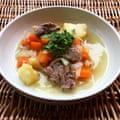
The important thing is to ensure you have enough meat to go round (though this isn’t a particularly meat-heavy dish) and enough bones to give flavour, so I’d suggest getting hold of a lamb neck and asking for it to be cut into chops, so you get the whole lot.
If you don’t happen to have a butcher handy, and don’t have the time to order online, go for cubed lamb, as recommended by Mena Rogers, a friend’s mum from Co Roscommon, who was taught by her own mother, Anne Gilhooly, who wowed everyone with her cooking just before the war. Clodagh McKenna similarly recommends stewing lamb, which generally comes from the neck, shoulder, breast or even shank, though using boneless meat will mean you need to find some decent stock.
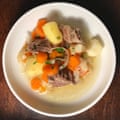
Potatoes
As food writer Niamh Shields puts it: “Irish stew without potatoes is not Irish stew – this is non-negotiable.” What sort of potatoes, however, is somewhat less straightforward. Most older recipes just call for potatoes without further detail, but more modern versions are usually more discriminating, with Allen, Henry and Hugh Fearnley-Whittingstall calling for floury or even “very floury” varieties.
The distinction is important, because, in England at least, we don’t really do floury in the same way as they do across the water: here, the most widely available floury potatoes are roosters (22% “dry matter” – for that is the enticing way the consistency of potatoes is measured), followed by maris pipers (21.8%), desirees (20.8%) and king edwards (20.5%). This, of course, varies widely by size and season, but none of them can touch the imported golden wonders I find at an Irish butcher up the road, also, apparently, known as “great balls of flour”. These, Allen’s kerr’s pink and Shields’ queen’s potatoes are far fluffier than any of the above, so if you can find them, go for them, because the flourier the potato, the better it will be at thickening the stew. As Henry observes, the potatoes should be simmered long enough to break down into the liquid – indeed, if you slice them as thinly as All in the Cooking recommends, they’ll break down almost completely into a thick, gluey sauce, rich with fat: utterly delicious, but almost more mash than stew.
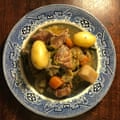
One solution is to add them in stages. Deidre tweets me from Cork: “A few potatoes should be chopped so they fall asunder in the stew and act as a natural thickening agent. The others are added for the last 15-20 minutes or so.” Corrigan even uses two types of spud: one floury to melt into the stew, one waxy to stay intact. Personally, I prefer the fluffiness of the floury kind for gravy-soaking purposes, so I’m going to start the stew with a layer of sliced potatoes and add some whole ones for the final half-hour, though if you’re not a floury potato fan, you may wish to go down his route instead.
The other veg
Onions are the only other must-have. All in the Cooking’s Irish stew, which generations of young cooks would have started with, contains only four ingredients – meat, potatoes, onions and water, plus a parsley garnish – and Sheridan’s is the same, though with thyme instead of the parsley. They’re surprisingly good for something so very plain: it turns out that, for all of our fancy tastes, meat and tatties can still make us happy on a cold, grey day.
Carrots are the most popular extra, though I find little evidence that these are more of a southern thing, as David Tanis claims in the New York Times. Sheridan allows that they may be served on the side, but insists that “it is quite wrong to cook carrots with this stew, as the long cooking will leave them insipid”. Testers enjoy their sweetness, but I’m inclined to agree that they do become mushy in the time it takes to cook the meat properly, so, like Henry, I’m going to add them at a later stage.
Celery is next up, used by Rogers and Laverty. I’ll be honest, I don’t much care for celery in any form, so I don’t feel bad about leaving that out. I do very much like the cornucopia of other veg in Rogers’ stew, though: turnip (which here, apparently, means the orange thing I’d call a swede), leek and a little bit of cabbage, “just for colour”, all in a delicious, meaty broth. It really is a complete meal in a bowl, though far be it from me to urge you into such heresies. (Try it though, it’s lovely.)
Allen suggests using tiny baby carrots and onions in her spring recipe, which is a nice idea if you want this dish to look a little more elegant (in which case you might want to use little salad potatoes as well).
The liquid and flavourings
Herbs and spices tend, unsurprisingly, to be kept fairly simple: bay, parsley and thyme are popular, with chives and parsley the most common toppings. Gary Rhodes and Rachel Allen both add garlic, but this seems to me a dangerously fancy road to go down. If onions are good enough for the domestic science syllabus, they’re good enough for me.
The same goes for wine or stout: some modern recipes moisten the stew with stock, but this should be necessary only if you’re using boneless stewing meat: good-quality lamb stock is hard to get here, so I use chicken instead in the Ballymaloe recipe, and it works out very well. If not, then let’s be honest, a cube isn’t going to bring the sky down on your head.
Even better, however, is to make a stock from the stew meat itself. Corrigan takes it off the bone and uses the bones to make a stock, while Henry slow-cooks shanks in water and aromatics until tender, then strains the resulting broth to cook the vegetables in. Both excellent recipes, but if you’ve managed to get hold of lamb neck on the bone, it’s easier to cook as is and pull off the meat off the bone before serving (or let people do it themselves on their plates): the gravy will still be rich and full-flavoured, and it’s far less faff.
That said, all beasts are different, and if you taste the gravy and decide it’s still underpowered, Rogers’ dash of Worcestershire sauce, or indeed the Oxo cube apparently favoured by many Irish grannies, are your rescue remedies. And if you’re feeling really daring, then chef Michael Clifford of the legendary Clonmel restaurant Clifford’s used to add a good glug of double cream to his stew, while Lindsey Bareham recommends a knob of butter. Just don’t say I told you to do it.
The method
Traditionally, it seems, the ingredients would have been put in the pot raw, as Laverty, Theodora FitzGibbon and All in the Cooking’s recipes dictate, but more recent versions, such as the Ballymaloe one, brown the meat and veg first, with Allen and Shields both rendering fat from the meat for the purpose. Neck doesn’t tend to come with great lumps of fat, but I do think it’s worth softening the onions if you have time; raw onion is a remarkably persistent flavour, even after two hours in the oven, so it’s 15 minutes well spent. The rest, however, can go in raw: this is a dish of soothingly mild flavours, patiently extracted over a low heat; traditionally over the fire, of course. But, as with any slow-cooked dishes, it’s easier to keep the temperature constant in a medium oven – and as Allen so perspicaciously observes, “a stew boiled is a stew spoiled”.
One thing that is worth spending time on, however, is skimming the fat from the gravy, as Allen also recommends (though you don’t need to thicken the gravy with a roux afterwards, unless your potatoes have failed in their thickening duties). As Rogers and Shields point out, Irish stew tastes even better the next day, so the easiest way to degrease is to drain the stew, then chill it and the liquid separately, so the fat solidifies on top of the gravy.
Perfect Irish stew
Prep 20 min
Cook 2 hr
Serves 6
2 tbsp oil or lamb fat
3 large onions, peeled and thickly sliced
10-12 medium very floury potatoes, depending on size and hunger, golden wonder or kerr’s pink are ideal, if you can get them; otherwise rooster, desiree or maris piper
1 neck of lamb, hogget or mutton, cut into thick slices
2 sprigs fresh thyme
6 carrots (optional; substitute some of these for chopped turnip, swede or leek, if you like)
Chopped parsley or chives, to serve
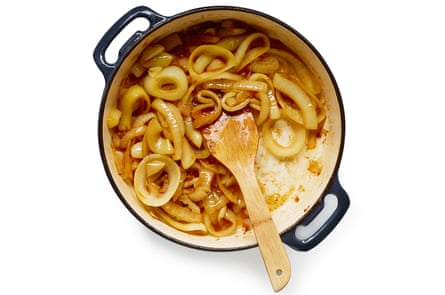
Heat the oven to 180C (160C fan)/350F/gas 4. Heat the oil in a large casserole dish over a medium flame and sweat the onions until soft and golden, but not browned. Meanwhile, peel four of the potatoes and slice thinly.

Take the pot off the heat, tip the onions into a bowl and line the base of the pan with sliced potato. Tip the onion back into the pot, along with the meat and thyme, season generously and pour in 850ml cold water. Bring to a bare simmer, then cover and transfer the casserole to the oven for an hour and a half.
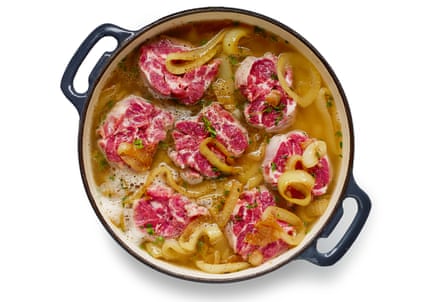
Shortly before the end of this time, peel the carrots and remaining potatoes, and cut into large chunks. Stir the carrots into the pot and put the potatoes on top. Leaving the lid slightly ajar, cook for another 30 minutes, by which time the meat should be very tender and the sliced potatoes all but disintegrated into the gravy.

Strain the gravy and, if eating immediately, spoon off and discard the grease from the top before adding back to the casserole and reheating. If not, chill the gravy, then lift off the solidified fat before pouring back into the dish and reheating; you can strip the meat from the bone at this point, if you like.
Taste, season if necessary and top with chopped parsley or chives. Serve with pickled red cabbage or steamed greens.

Comments (…)
Sign in or create your Guardian account to join the discussion